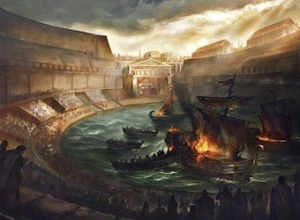Juvenal, the Roman poet, said, “The people that once bestowed commands, consulships, legions, and all else, now concerns itself no more, and longs eagerly for just two things – bread and circuses!” Most if not all of you have heard that quote before, particularly if you’re familiar with the Suzanne Collins Bestseller, The Hunger Games (which takes place in a fictitious, post-apocalyptic North American nation called Panem – Latin for bread). But what exactly does the phrase imply?
It means that the proverbial Powers that Be can get away with literal murder, rape, robbery, and everything else, provided they divert the eyes of the masses to entertainment, while at the same time keeping their bellies full. As long as the public has the means to eat and to distract themselves with games, they’ll ignore everything and everyone, including their misdeeds.

At the height of the Roman Empire, the Colosseum in the capital city was primarily where those games took place. Truthfully, it was only the largest arena in the largest city in the empire, but all cities had arenas of varying sizes that held varying types of circuses and games. Similarly today, every major city across the globe hosts some type of sports arena whether it be for football, baseball, cricket, rugby, basketball, or tennis.
We have certainly produced our fair share of games. And just like the emperors of old – doing whatever they wanted – we have our own power-brokers who take advantage of us with variable interest rates (and other garbage) while we’re waiting idly for the snap on the line of scrimmage.

Back then though, one of the most exciting (and bloodiest) forms of this entertainment was that of the gladiatorial combat. The gladiator was an entertainer who fought for his very life, with weapons and sometimes without, in front of tens of thousands of screaming spectators. Some were criminals, some volunteers, most slaves of some sort. This version of entertainment lasted almost a millennium, and boasted a wide range of styles. Listed below are some ‘other’ types of fights than the standard one-on-one gladiator battles (which was by and large the most popular).
- Bestiarii – beasts, including but not limited to lions, tigers, and bears (oh, my!), were used in a variety of ways from slaughtering criminals to parading around for mere show
- Noxii – mythological reenactments from the stories of their pagan religion were possibly one of the most popular types of games as the “battles” were often fixed so that the correct side would come out victorious (if you’ve seen the Ridley Scott film, Gladiator – which won an Oscar for Best Picture in 2000 – then you’ve seen this game)
- Comoedii – comedic fight scenes with no real victims or casualties were used between matches to “clean up” and give the audience a rest and chance to get some refreshments
- Supplicii – criminal executions were very creative as the victims were sometimes blindfolded and told to fight each other, or just put in front of wild animals without any weaponry
- Aurigas Cursoresque – chariot races (self-explanatory) weren’t held at the Colosseum in Rome but across the street at the Circus Maximus

Sometimes the arena floor would even be flooded to reenact a mythic water battle, but usually if the emperor wanted, he could command the entire audience to move to a nearby lake for that portion of the show. I don’t know about you but that sounds a lot more exciting to me than watching a bunch of sweaty Europeans kick around a ball.
Hasta La Proxima…
-Justin
Very different and entertaining blog. Thanks